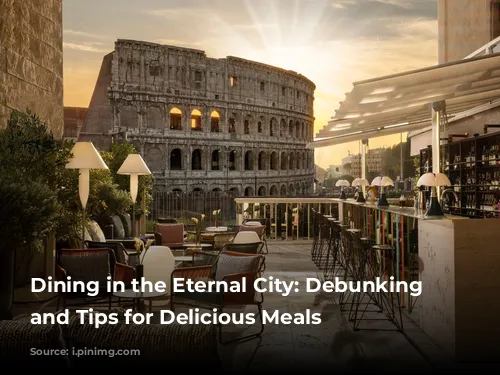Rome, a city overflowing with history and culture, also boasts a vibrant culinary scene. It’s a foodie paradise where every corner seems to whisper tales of delicious pasta, savory meats, and heavenly desserts. While most dining experiences in the Eternal City are pure joy, some common myths and misconceptions can cloud your judgment and lead you astray. Let’s shed light on these myths and arm you with valuable tips to ensure you have an unforgettable culinary journey.
The Myth of Multiple Courses
Myth: You must indulge in a multi-course meal, with a starter, pasta, main course, and dessert.
Reality: This notion, though prevalent in the past, is no longer a strict rule. Portion sizes have increased over the years, allowing you to savor individual dishes without feeling obligated to complete a lengthy meal. Feel free to order what your heart desires, be it a single dish or a selection of appetizers to share.
If you find yourself still hungry, don’t hesitate to order more. High-end restaurants often offer tasting menus, showcasing a variety of flavors and textures. However, even with the smaller portions, the numerous “compliments of the chef” treats can quickly add up.
Remember, flexibility is key! Order à la carte, share dishes, or skip a course altogether. Your dining experience should be tailored to your preferences and hunger level.
English on the Menu Doesn’t Mean Bad Food
Myth: English on the menu signifies subpar food quality.
Reality: Many talented chefs in Rome have embraced international influences, having lived abroad, traveled extensively, and recognized the power of social media to attract a diverse clientele. Rome, a global city, thrives on tourism, and English translations on menus are becoming increasingly common, reflecting this international appeal.
While it’s wise to exercise caution, don’t automatically dismiss a restaurant solely because it offers English translations. Instead, focus on other indicators such as the quality of ingredients, the chef’s background, and the ambiance of the restaurant.
High Tourist Areas Don’t Always Mean High Prices
Myth: Restaurants in high tourist areas are inherently overpriced and serve subpar food.
Reality: While this statement holds some truth, it’s not a universal rule.
Common sense dictates that restaurants situated in prime locations, like Piazza Navona or near the Trevi Fountain, pay a premium for the visibility and foot traffic. Consequently, they may charge higher prices.
However, don’t let this deter you from exploring the area. Look for smaller, less conspicuous establishments tucked away in side streets. You might discover hidden gems serving delicious meals at reasonable prices.
Rome is Not a Rip-Off Capital
Myth: Some Roman restaurants are notorious for ripping off tourists.
Reality: While there are always exceptions, Rome is not known for widespread scams. The law requires restaurants to display menus with clear prices, so there is no room for hidden charges.
Always check the prices before ordering, especially for dishes prepared by weight, such as fish or specific cuts of meat.
Don’t assume anything is free, particularly in upscale restaurants. Inquire about the cost of any extra items, like a starter drink of champagne, to avoid surprises on the bill.
Always inspect the bill thoroughly before paying, verifying that it matches the posted prices and that you are not being charged for anything you didn’t order.
Research is Your Best Friend
Myth: You can stumble into any charming restaurant in Rome and expect a decent meal.
Reality: While serendipitous encounters with delicious food are always delightful, relying solely on chance can lead to disappointing experiences.
Research is your best ally, especially when dining in high-tourist areas. Leverage online resources, travel guides, and food blogs to find recommendations from reliable sources.
Making reservations is often a wise move, as it secures your table and allows the restaurant to anticipate your arrival.
Eat Like a Local
Tip #1: Embrace seasonal flavors and explore local traditions. Rome’s cuisine reflects the changing seasons, with artichokes peaking in spring and hearty dishes taking center stage in winter.
Tip #2: Dine on Roman time. Lunch is typically enjoyed between 12 pm and 2 pm, while dinner starts around 7 pm, with some restaurants opening as late as 9 or 10 pm.
Tip #3: Embrace the aperitivo culture. Enjoy a pre-dinner drink, usually accompanied by small snacks, in a vibrant bar or restaurant.
Tip #4: Know the etiquette. Tap water is not customary at the dining table; bottled water is preferred. Avoid ordering soft drinks at meals, as they are often overpriced.
Tip #5: Be patient and understanding when it comes to service. Roman waiters are trained to provide a relaxed, unhurried dining experience.
Tip #6: Tipping customs in Rome may differ from your home country. Research local tipping practices to ensure you are leaving a gratuity that is appropriate.
Navigating the Culinary Landscape of Rome
Rome is a city where culinary delights await around every corner. By understanding common myths and embracing helpful tips, you can enjoy a truly unforgettable dining experience. Whether you’re indulging in a multi-course feast or savoring a single, perfectly prepared dish, let the flavors of Rome transport you to a world of culinary bliss.
